
Living Color on the Eardley Escarpment (part 1)
May 29th, 2017
On May 17th I went hiking in the Gatineau, taking the old McCloskey Road trail to McDonald trail and up to the Western Lodge. The display of spring ephemerals was even more outrageous than it was at nearby Wolf Trail last spring! The woods were like a garden. An endless profusion of Red Trillium, White Trillium, Trout Lily and Bellwort, with a little Bloodroot here and there, swampy spots overflowing with Marsh Marigold, and more besides. I came mainly to photograph the flowers--the birds of Eardley Escarpment are multifarious and good, but usually too far up in the trees for my lens to capture. But, as it turns out, there were a few surprises.
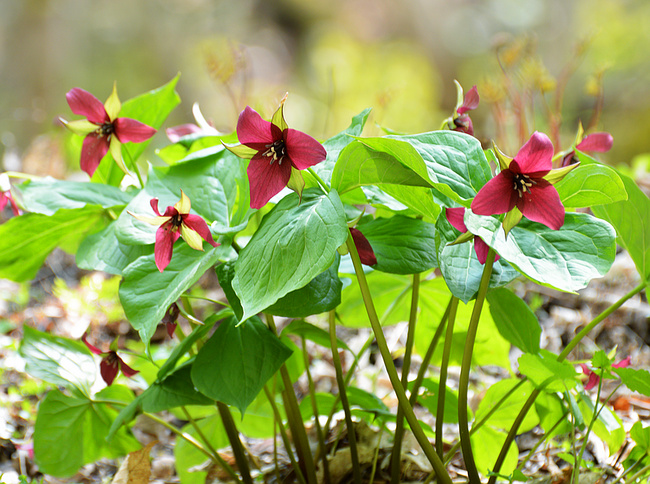
Red Trillium, wallpaper available

Red Trillium, wallpaper available

Trout Lilies

Bellwort

Bloodroot

These Marsh Marigolds formed thick golden carpets in swampy spots. I can't remember seeing them in such profusion before. I guess our very wet spring created good habitat for them!
Next up, the day's two surprises.
Upstaging The Warblers
May 23rd, 2017
I continue to be cursed for warbler photography at Point Pelee.
On the first day of our outing, there were lots of warblers, but almost none of them were out on the tip (where you can sometimes get extreme close-ups as these exhausted birds, having just flown across Lake Erie, drop into the low vegetation and, well, veg.) They were in places like Tilden Woods, flitting around high up in the trees. It's great for them that conditions were so good they could just breeze right past the tip and into the woods, but not so great for photography, especially not with my modest 300mm lens. I had a much better time (and saw more birds) once I finally stowed my camera away and went back to just binoculars. I saw seventeen types of warblers all in all, of which the highlights were a nice view of a Blackburnian, and an excellent view of a Northern Waterthrush.
The second day was much better, or so I'm told. Unfortunately I wasn't there, for reasons I won't go into.
But the trip wasn't a complete loss for photos. When we arrived at the tip of the tip, I was thrilled to see a number of Red-Breasted Mergansers, males and females, swimming close to shore. My group was eager to move on and find a rumored Tufted Titmouse, but I see all the titmice I need when I visit my folks in Virginia, and I don't see nearly enough of this unusual, charismatic duck--especially the drake in his full nuptial plumage. So I lingered behind, missed the titmouse, and got some photos of the nearest drake as he showed off for the ladies.

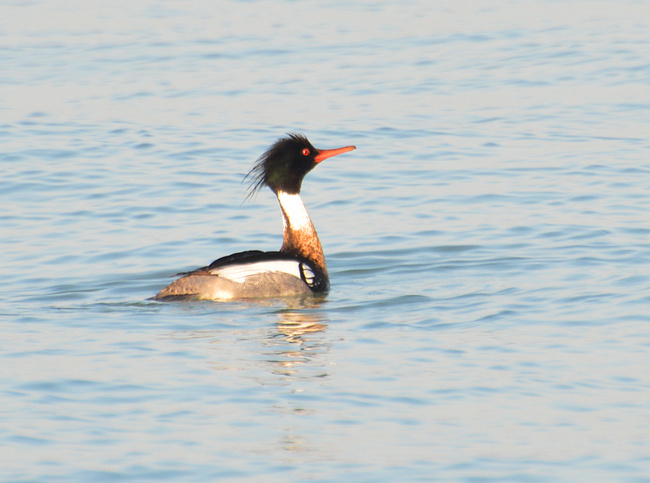

I also think this early-morning Barn Swallow came out rather well. A whole colony of these swallows breed in an open shelter near the tram stop, building their mud nests on ledges beneath the ceiling. They are completely habituated to humans, whizzing back and forth to and from their nests right over our heads.

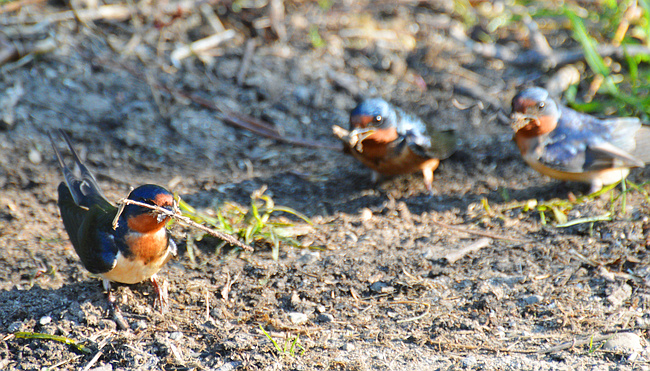
Gathering nest-building material.
Our disaster, their wonderland
May 19th, 2017
I went birding at Mud Lake on Wednesday the 10th. It was like no visit to Mud Lake ever before, and probably none hence. (For those of you in Ottawa, you maybe heard in the news about "flooding in Britannia"? Yeah. Britannia is where Mud Lake is.) I felt quite confident heading down the trail with a pair of knee-high rubber boots on. But even thus equipped I was unable to complete the loop.
The pond (connected with the swollen Ottawa River) had simply taken over. For large swathes of the trail, there was no trail. There were ducks paddling and fish swimming where there had once been a trail. And the Rusties, oh my god, the Rusties. Rusty Blackbirds, as I mentioned in my last post, are a species of icterids who love foraging on flooded ground. The rich brown coloration that gives them their name is only seen in fall and winter. By this time of year, females are charcoal and males are glossy black, with striking pale eyes, like miniature short-tailed grackles. In good light they show a steel-blue sheen. They are largely birds of the boreal forest and muskeg, breeding north of us, and their population is in decline. Normally if I see a few of them in a year I'm happy.
Mud Lake was dripping with Rusty Blackbirds, far, far more than I'd ever heard or seen. To them it was a wonderland. Anywhere there was water where there shouldn't be, there they were, strutting along the margins of the flood or perching over it, and filling the air with their odd, stuttery, gurgling songs. As I splashed my way down the "trail" I could see the flocks retreating before me--but now and then a straggler granted me a photo op. I was in heaven seeing, hearing and photographing so much of a bird that is usually elusive to me.
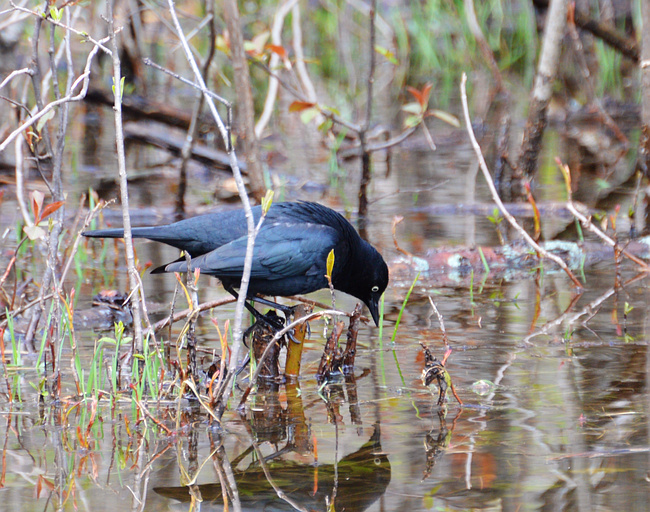
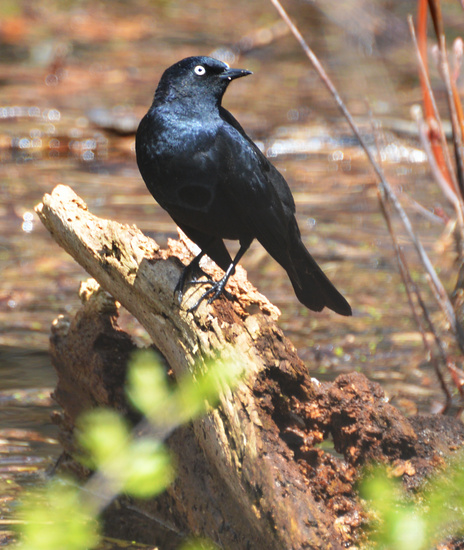

That was a trail once.

The west entrance to the ridge.
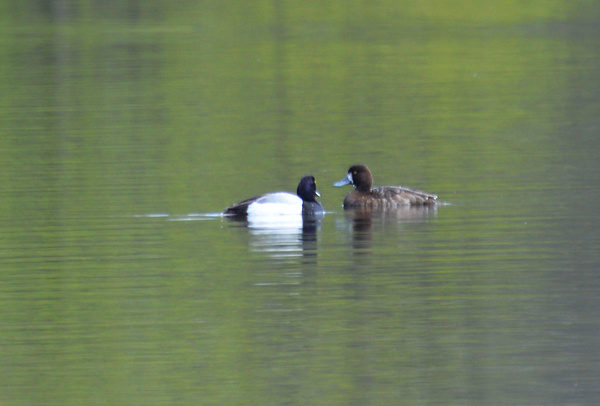
Another sign that we're not in Kansas anymore: a mated pair of Greater Scaup on Mud Lake. These are diving ducks who prefer fairly deep water. They show up mainly on large rivers (like the Ottawa) in migration, and breed on large lakes--actual lakes, which "Mud Lake" isn't. But in its flooded state, it must have looked like decent habitat to them!
( Continue (Rusties galore, a couple of warblers, trout lilies and more!) )
Of floods and falcons and other spring adventures
May 3rd, 2017
It's been a weird, wet, interesting spring.
In early April I made the traditional Ottawa birder's trek out to Cobb's Creek floodplain, near Bourget. Each spring Cobb's Creek floods and turns the surrounding fields into a shallow lake, attracting migrant waterfowl. I went twice, first solo and a few days later with Mike. On my solo trip I found the water mostly iced over, although that didn't dissuade the tens of thousands of Snow Geese! Few ducks to be seen, though.
I decided to go hiking down the old railbed trail. Not far down I found a long-tailed, light gray bird, singing away. Its song was a rather random-sounding series of phrases, some repeated. Well, I figured I knew what that had to be: my first Ontario mockingbird! I see mockingbirds galore whenever I visit my parents in the southern states, but it was still exciting to see one close to home, where they are quite rare.
But then I twigged to something...what was with that dark streak through the eye? Mockingbird doesn't have that. Then the "mockingbird" flew and alit on another tree in much better lighting, flicking its tail, and my mistake became clear. Black mask, hooked bill, faintly barred breast: not a mockingbird but a Northern Shrike. Though this was not an Ontario first, it was just as exciting, simply because I'd never found a shrike singing before. Shrikes are oddities of evolution, carnivorous songbirds that actually catch and eat other birds (and rodents.) Lacking sharp talons to hold onto their prey, they have developed the grisly habit of impaling it on barbed wire or a thorny branch. Chickadees dread them. It seemed so surreal for this fierce raptor (well, pseudo-raptor) to be singing cheerily!
A few days later I went back with Mike, and all was changed. The ice was off the water, and the water had swelled to become the most impressive flood I'd ever seen. It actually had waves. It had positively overshot the water level preferred by dabbling ducks, so again, there were few to be seen. Instead of duck-watching we ended up muskrat-watching! Hard to believe how many of them were paddling around in there.
In mid-April, around the time when Michael and I were contending with our flooding basement window well, I went hiking at Shirley's Bay and came to a spot where the river had simply swallowed the trail whole. Rubber boots would not have sufficed, hip-waders may have sufficed, but frankly, I'd put my money on a canoe. So I turned back, but not before having seen a wealth of migrant birds, including the largest group of Rusty Blackbirds that I'd ever found in spring. Rusties are grackle-like blackbirds (but smaller and shorter-tailed) who forage for food on swampy, flooded ground. Is it a coincidence that this is the spring when I see my biggest spring group of Rusties ever? I doubt it.
At the end of April, we hiked the Rideau from Billings Bridge to Hog's Back Falls and back. Highlights included a male Red-Breasted Merganser acting surprisingly pair-bonded with a female Common Merganser, and a Double-Crested Cormorant in resplendent breeding plumage, with an all-over indigo sheen and a gular pouch so strikingly yellow it looked painted. (Cormorants only look like that for a short time each year. In fact, seeing this bird made me realize that much of what I admired about the Great Cormorants in Cape Breton was due to finding them at peak season, and not due to their particular species.)
But the big highlight came near Billings Bridge, as we were walking back through the park lawn and a long-tailed light gray bird flew into a bush, flashing white wing patches. "I'm pretty sure that was a mockingbird," I told Mike.
"You're kidding," he said.
Since I had recent experience of mistaking a shrike for a mockingbird, I didn't want to be cavalier. So we waited patiently until the bird finally flew out, perched in a tree, and gave us a good look. There was then no question. Ontario-first Northern Mockingbird, for real this time! I reported it on Ontbirds, and about an hour later, it had been re-found by Paul Mirsky. Two others reported it early the next morning. This was exciting for me, as I don't often get to be a first finder of rarities, and the last time I was (the European Goldfinch at my feeder in 2015), the bird split before anyone other than me and my husband got a chance to enjoy it.
That brings me to this morning at Mud Lake, where I found the trail flooded in places it has never flooded before. (This is going to end eventually, right? We're not going to need an ark?) It was a cold morning with very few spring migrants to be seen, but one sighting from Cassels Road made my day by itself. All the Red-Winged Blackbirds in the vicinity began making alarm calls, and then a large raptor swooped in and started circling. When you see a raptor flying over Mud Lake you expect a Cooper's Hawk or an Osprey, maybe a Merlin (a small falcon) if you're lucky. This bird was definitely a falcon by shape, but it outsized any Merlin and had the thick black sideburns of the Merlin's more famous relative, Peregrine Falcon! And now that it was overhead the blackbirds were making sounds like I had never heard them make. (If you are familiar with the redwing's usual piercing alarm call, imagine that, but furtive and muted instead of piercing, with a certain "oh shit" quality about it.)
Then it actually went into a stoop: it dove down at the water, veering up at the last minute. But I couldn't see anything there that it would have been stooping at. Maybe a young falcon practicing its moves?
Coming soon, rain with more rain and a side of rain. And coming hopefully after all that is over with, my big four-day trip to Point Pelee with Jon Ruddy.
Living Sunshine
April 15th, 2017
Grill season has arrived, and alas, that means that bird-feeding season is over, at least for me--the husband generally prefers not to get crowned with finch droppings while cooking our dinner :-) And I prefer to only feed birds in the coldest, most difficult months so as not to create dependency.
I got this photo just before I discontinued feeding. These two males were in almost perfect breeding plumage (compare with the more dishevelled appearance in my previous post, and then with the bare winter plumage in the post before that.) Goldfinches are so shy out in nature--I had never before been able to approach them closely enough to get a picture like this. But at feeders they can become a good deal more tame, and these had all winter to get used to me. I was right across the window from them.

Tiding Us Over
March 30th, 2017
In mid-May, Michael is joining me for a four-day bird-watching trip to Point Pelee, led by birding dynamo Jon Ruddy. This will be my third time in Point Pelee at the height of spring migration, and I'm thrilled to be going back. Hopefully, for the first time, I can get good photos of the warbler extravaganza. (The first time I got some photos, but mostly not of warblers. The second time my back gave out and I had to stow the camera away. This time, I'm planning to buy a camera harness to help with the back issues.)
In the meantime, here are a few recent and not-so-recent photos. This first one is the last of my summer 2016 backlog. I call it "Reaching For The Sun", which is rather what I'm doing around now in Ottawa!
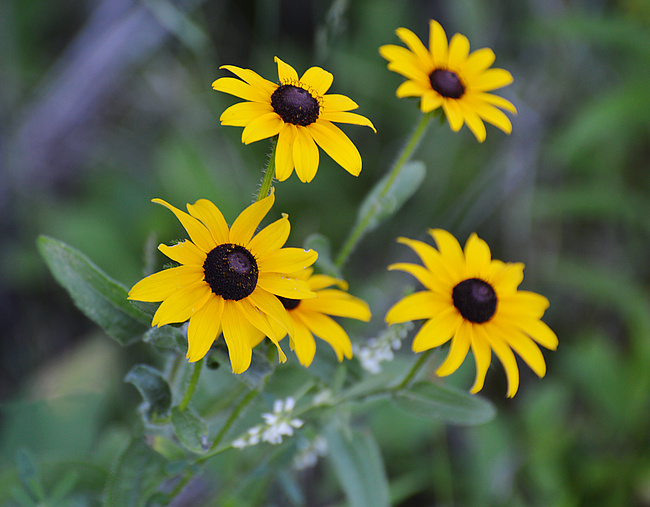
1680x1050 wallpaper
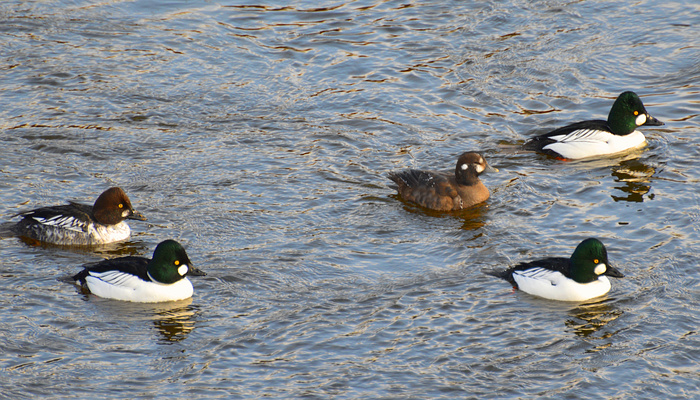
This young male Harlequin Duck (the brown one in the middle) spent the winter on the Rideau River, often near Hurdman Bridge. On this day in mid-January he was keeping close company with a group of young male (the leftmost duck) and adult male Common Goldeneyes. The large majority of Harlequins live in the west, breeding on turbulent mountain streams in places like Banff. The Atlantic population, which is presumably where this one strayed in from, is small and endangered.
The adult male Harlequin is spectacularly handsome; unfortunately we seldom see one of those here in Ottawa. However, we might if this guy sticks around long enough! I saw him again just today, and while he wasn't showing much color yet, the markings on his face were a lot more well-defined and striking.
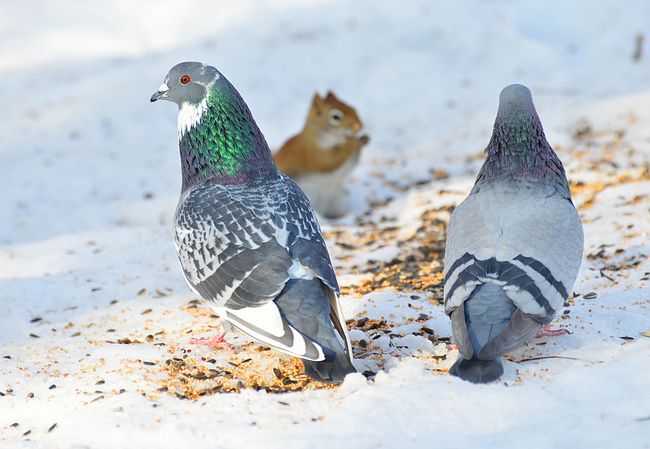
1680x1050 wallpaper
It saddens me that birders snub so many interesting birds because they're common, or non-native, or otherwise uncool. I've made it my mission to keep seeing the beauty in what some call "dirt birds." Today's exhibit: a resplendent Rock Pigeon, sharing birdseed with another pigeon and a Red Squirrel along the Rideau River.
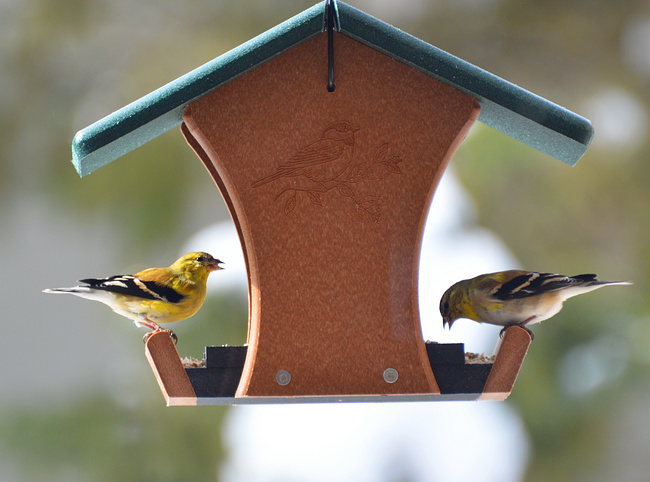
Photographed just a few days ago, goldfinches at my kitchen balcony feeder. These two males are molting out of their drab winter plumage and into their dazzling yellow summer plumage. The one on the left was further along in his molt and looking very pretty, I think!
Winter in Algonquin: Visitor Centre and Opeongo Road
February 7th, 2017
At the Visitor Centre I had some welcome hot food, then headed to the viewing platform to check out the famous feeders. They usually have a flock of Evening Grosbeaks in winter, but on this afternoon it was goldfinches, plus the odd redpoll and siskin.
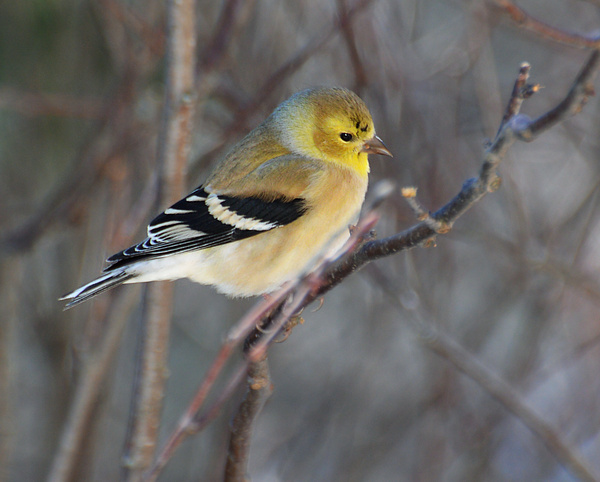
1680x1050 wallpaper
I enjoyed the sight of goldfinches crowding into the surrounding trees waiting their turns.
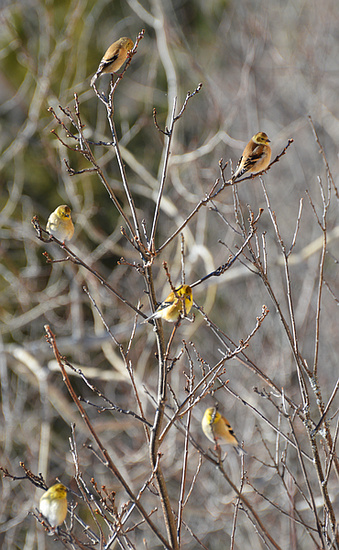
Another interesting but very distant (too distant for pictures) sight from the platform was a moose carcass being fed on by a red fox. The moose had been road-killed, and park staff put it out in the valley for the benefit of scavengers. So far a fisher, a marten, the fox, ravens, wolves, and a Bald Eagle have all been seen at the carcass! The scavenger-fest (if it's still on by the time I post this) can be viewed on live webcam at the Algonquin Park website.
After lunch we headed to Opeongo Road, where, at the junction where the road is gated off, we were met by another friendly, hungry group of Gray Jays. This time I decided to photograph the action. I found this kind of photography very rewarding--capturing the joy on peoples' faces as birds alight on their hand with complete trust.
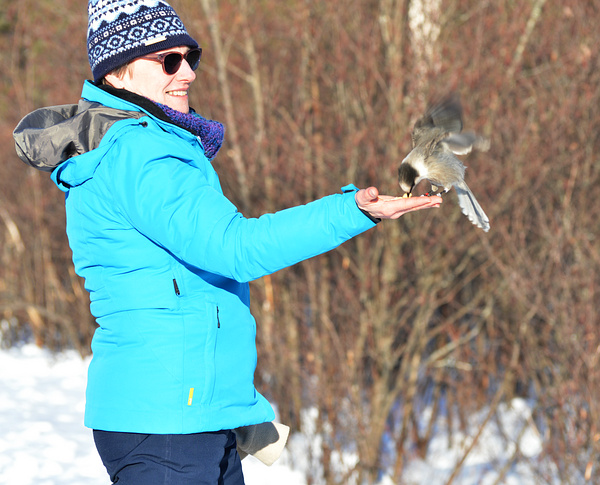
That's "WOSLROWR" (white over standard left, red over white right), the just one-year-old territorial female of Cameron Lake Road.
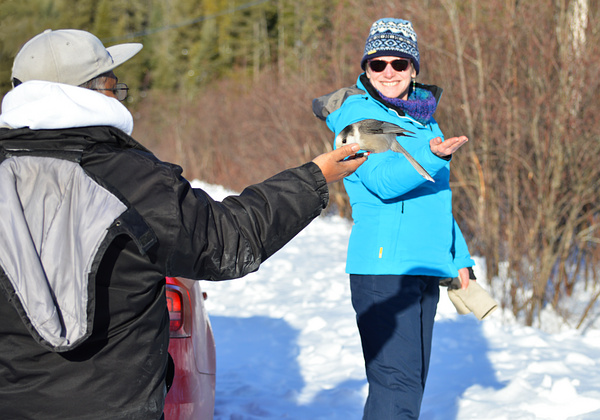
Her six-year old mate.
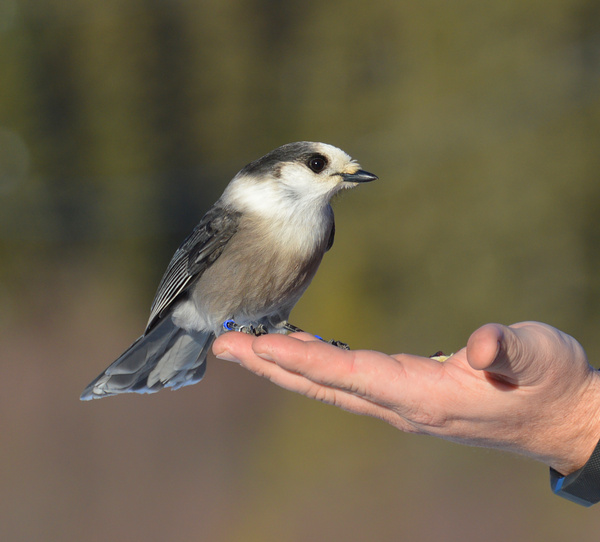
1680x1050 wallpaper
"GOBLBOSR" (green over blue left, blue over standard right) - an unrelated male in the same territory. He was probably originally evicted from his natal territory. A pair may be willing to "adopt" an unrelated jay if they have no surviving offspring. He will stay with them for a little while until he can find a place to call his own.
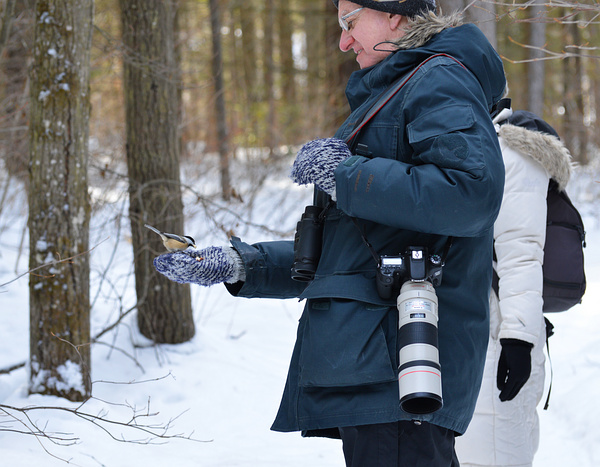
Don't forget the chickadees!
Winter in Algonquin: Spruce Bog Boardwalk (part 2)
January 31st, 2017
We were not long past the parking lot when the high point of my trip happened: the sight of male Evening Grosbeaks gathered on the boardwalk railing, their burnt-gold bodies blazing against the snowy backdrop.

1680x1050 wallpaper
We have a small, remnant population of Evening Grosbeaks near Ottawa, in the area of Larose Forest. But they're difficult to find in the wild. (In winter they show up at the feeders of people who live adjacent to the forest. I envy those people!) They were once much more common.
Almost immediately after the grosbeaks was my very first male Spruce Grouse. I had searched high and low for them the last two times I went to Algonquin, with no luck. And it's anyone's guess whether I would have seen this one without help. Just like the female Spruce Grouse Michael and I found in Cape Breton, he was up in a spruce tree noshing on needles and making no sound. He regarded the gaggle of bird-watchers with an unruffled air.

1680x1050 wallpaper
A look at that pretty face:
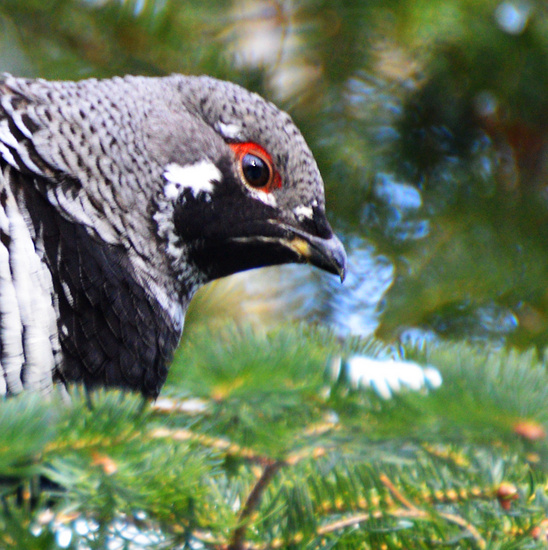
Another point of interest at the spruce bog was a lone Boreal Chickadee, in with a group of familiar Black-Capped Chickadees, coming to birdseed that someone had scattered on the ground. Note the brown cap and the almost chestnut-colored flanks, as compared to Black-Capped's black cap and buffy flanks.
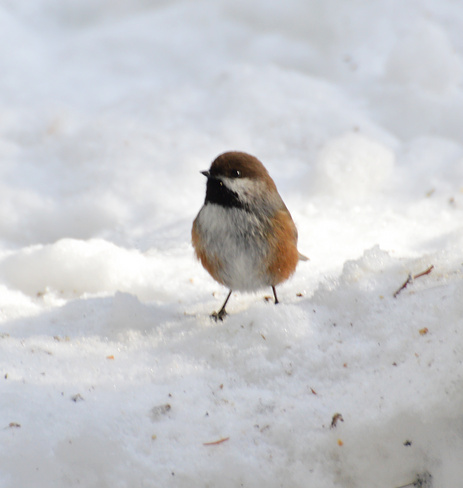
(More to come)
Winter in Algonquin: Spruce Bog Boardwalk (part 1)
January 27th, 2017
Next that morning was Spruce Bog Boardwalk, one of the most popular spots in Algonquin in winter. I quickly learned why. We were met at the parking lot by a friendly group of Gray Jays. You may have heard the name "Gray Jay" recently: it's been proposed as the new national bird of Canada. There has been some consternation from folks who would rather it be the Common Loon, or who just have no idea what a Gray Jay is and what's special about it. So let me introduce you.

1680x1050 wallpaper
A big, fluffy, soft gray teddy bear of a bird. It's nearly as big as a Blue Jay, but as cute as a titmouse. A confiding and curious bird that readily comes to a human hand to take peanuts and fruit. An intelligent bird that caches food in thousands of different hiding places and remembers each one. A tough-as-nails bird that lives in northern Canada year-round (Algonquin Park is at the extreme southern limit of its range) and incubates eggs in the middle of a boreal winter. Friendly, smart, and unfazed by extreme cold: what better bird to represent Canada?
I fell in love with them. Instantly. As with Evening Grosbeaks, I had seen them before, but not like this.
A Gray Jay pair is strictly monogamous and lives in the same territory (roughly 150 hectares each in Algonquin) year-round. As the pair's young mature, they will increasingly fight with each other until one is established as dominant, and drives its fledged siblings away. That individual gets the privilege of living in its parents' territory for the rest of the year, and maybe even the year after that. The others must hunt for a vacancy elsewhere and have a somewhat lower chance of survival.
It is a rather odd and unique family arrangement among birds. In most species that allow young to remain after fledging, the young pay their room and board, as it were, by helping feed the next generation of nestlings. But Gray Jay parents actually refuse to allow their teenagers to approach the nest! Not until the chicks are out of the nest are the older siblings allowed to help feed them.
The Gray Jays resident along the Highway 60 corridor are all banded as part of a long-term study. Their bands uniquely identify them. The individual pictured above, if I've determined correctly, is Mr. ROSLGOPR (red on standard left, green on purple right). He's the dominant juvenile in the Sunday Creek territory, staying with his parents for the second year. He is also fitted with a radio transmitter. That thing that looks like a stray twig in front of his tail is the antenna.
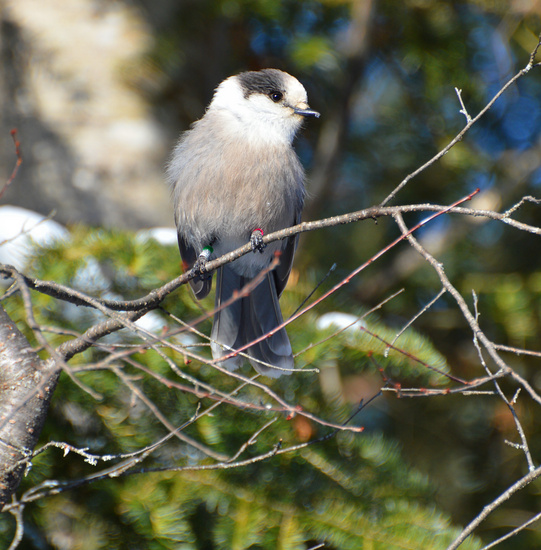
1680x1050 wallpaper
That's the breeding female in the Boardwalk territory, six years old.
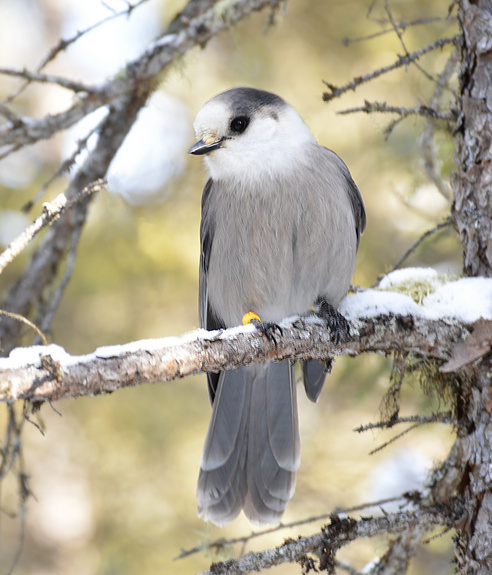
And that's her six-plus-year-old mate. By the way, the oldest known Gray Jay in Algonquin Park is sixteen!
(More to come)
Winter in Algonquin: Pine Grosbeaks and Pine Martens
January 22nd, 2017
Around the start of our trip, we came across a flock of female and juvenile Pine Grosbeaks on the roadside, and carefully pulled over to watch them.
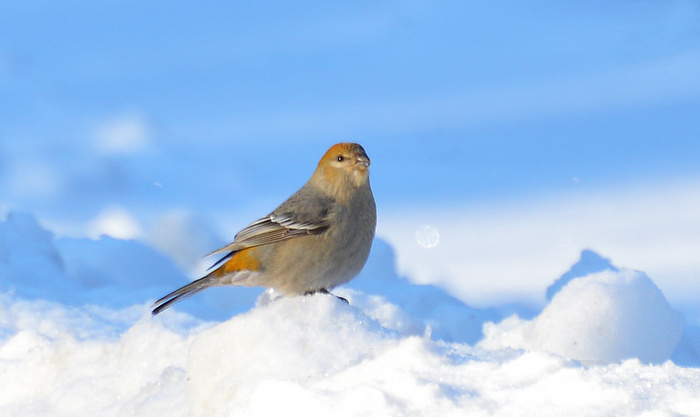
1680x1050 wallpaper
Like many finches, Pine Grosbeaks need to eat grit to help them digest their food, and roads are a good place to find it--but also a dangerous place. It was a nervewracking moment for us when we heard a car coming fast around the bend, but they all flushed just in time.

Drive carefully in the park!
One male White-Winged Crossbill wasn't so fortunate. Jon found him freshly killed on the road. A beautiful bird even in death, and it would have been my only decent picture of a crossbill on this trip, but I didn't have the heart. Happily we also saw many healthy White-Winged Crossbills in multiple places, crowding into spruce trees and prying open the cones to get at the seeds, their favorite and usually only food.
(Here's a photo of one of the crossbills we saw taken by Laura, aka "The Afternoon Birder." It shows the unique crossed mandibles that they use to twist open conifer cones.)
A morning stop at Mew Lake Campground gave us some photogenic Blue Jays--
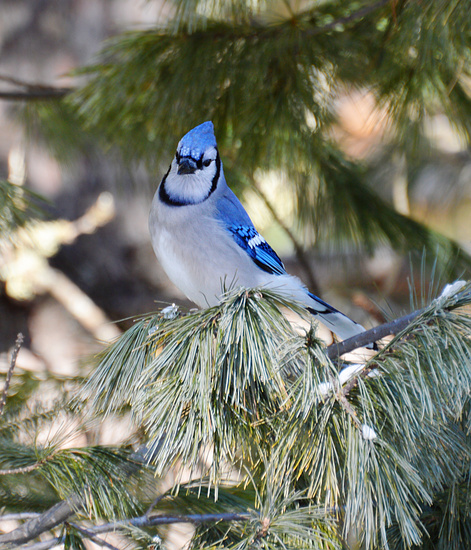
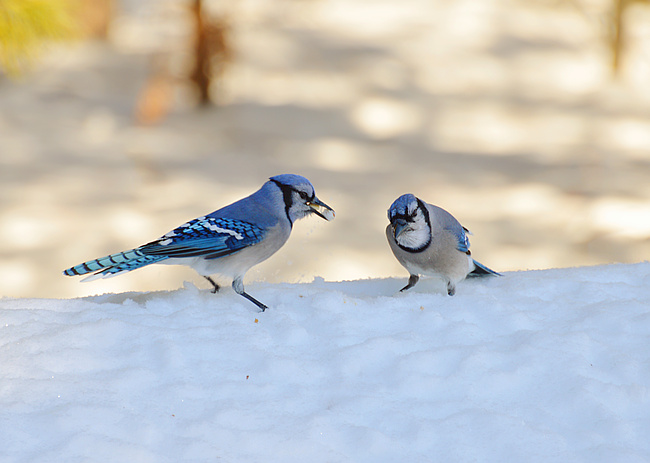
--and a thrilling, close-up view of a family group of Pine Martens! This was my one lifer of the trip---a mammalian lifer, not a bird. Pine Martens are mustelids, relatives of weasels and minks among others, that live in northern coniferous woodlands. I found them enchanting. They were far more arboreal than other mustelids I've encountered, scampering and leaping through trees with the agility of monkeys. I tried to get action shots, but they were just too fast for my shutter. The only good pictures were when they paused to have a look at us.
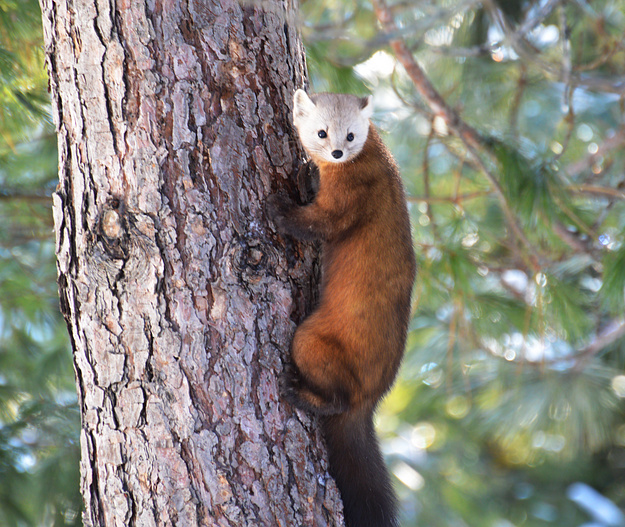
1680x1050 wallpaper
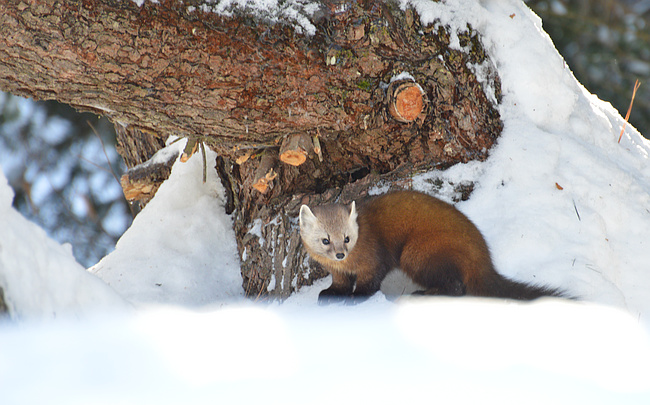
(More to come)
|
